Review of Biofuel Effect on Emissions of Various Types of Marine Propulsion and Auxiliary Engines
Abstract
1. Introduction
2. Overview of Biofuel Effect on Engine Fuel Consumption and NOx Emissions
3. Measurement Particulars
4. Results
4.1. Propulsion Two-Stroke Low-Speed Engines
4.1.1. Performance Effect on Two-Stroke Low-Speed Engines
4.1.2. Emissions of Two-Stroke Low-Speed Engines
4.2. Auxiliary Four-Stroke Medium-Speed Generators
4.2.1. Performance Effect on Four-Stroke Medium-Speed Generators
4.2.2. Emissions of Four-Stroke Medium-Speed Generators
5. Conclusions and Future Work
Author Contributions
Funding
Data Availability Statement
Conflicts of Interest
Nomenclature
| CI | Compression ignition |
| CN | Cetane number |
| FAME | Fatty acid methyl ester |
| FC | Fuel consumption |
| GHG | Greenhouse gas |
| HFO | Heavy fuel oil |
| IMO | International Maritime Organization |
| ISO | International Organization for Standardization |
| LCV | Lower calorific value |
| MGO | Marine gas oil |
| Pcomp | Compression pressure |
| Pmax | Maximum combustion pressure |
| Pscav | Scavenging pressure |
| BSFC | Brake specific diesel fuel consumption |
| SOI | Start of injection |
| VLSFO | Very-low-sulfur fuel oil |
| ΔP | Pressure increase due to combustion |
References
- Lloyd’s Register. IMO GHG Strategy–What Does It Mean? 2018. Available online: https://www.lr.org/en/insights/articles/imo-ghg-strategy-what-does-it-mean/ (accessed on 20 March 2023).
- IMO. Initial IMO GHG Strategy. International Maritime Organization. 2022. Available online: https://www.imo.org/en/MediaCentre/HotTopics/Pages/Reducing-greenhouse-gas-emissions-from-ships.aspx (accessed on 20 March 2023).
- Sou, W.S.; Goh, T.; Lee, X.N.; Ng, S.H.; Chai, K.H. Reducing the carbon intensity of international shipping–The impact of energy efficiency measures. Energy Policy 2022, 170, 113239. [Google Scholar] [CrossRef]
- IMO. Rules on Ship Carbon Intensity and Rating System Enter into Force. IMO. 2022. Available online: https://www.imo.org/en/MediaCentre/PressBriefings/pages/CII-and-EEXI-entry-into-force.aspx (accessed on 20 March 2023).
- Chuah, L.F.; Mokhtar, K.; Ruslan, S.M.M.; Abu Bakar, A.; Abdullah, M.A.; Osman, N.H.; Bokhari, A.; Mubashir, M.; Show, P.L. Implementation of the energy efficiency existing ship index and carbon intensity indicator on domestic ship for marine environmental protection. Environ. Res. 2023, 222, 115348. [Google Scholar] [CrossRef]
- Comer, B.; Chen, C.; Rutherford, D. Relating Short-Term Measures to IMO’ s Minimum 2050 Emissions Reduction Target. ICCT Working Paper 2018-13. 2018. Available online: https://theicct.org/wp-content/uploads/2021/06/IMO_Short_term_potential_20181011.pdf%0Ahttps://www.theicct.org/sites/default/files/publications/IMO_Short_term_potential_20181011.pdf (accessed on 20 March 2023).
- IMO Symposium on Alternative Low- and Zero-Carbon Fuels for Shipping. Available online: https://www.imo.org/en/About/Events/Pages/IMO-Symposium-on-alternative-low--and-zero-carbon-fuels-for-shipping-2022.aspx (accessed on 20 March 2023).
- Kass, M.D.; Abdullah, Z.; Biddy, M.J.; Drennan, C.; Haq, Z.; Hawkins, T.; Jones, S.; Holliday, J.; Longman, D.E.; Menter, S.; et al. Understanding the Opportunities of Biofuels for Marine Shipping. 2018. Available online: www.osti.gov (accessed on 20 March 2023).
- Li, S.; Tan, E.C.D.; Dutta, A.; Snowden-Swan, L.J.; Thorson, M.R.; Ramasamy, K.K. Techno-economic Analysis of Sustainable Biofuels for Marine Transportation. Environ. Sci. Technol. 2022, 56, 17206–17214. Available online: https://pubs.acs.org/doi/full/10.1021/acs.est.2c03960 (accessed on 20 March 2023). [CrossRef]
- Tan, E.C.D.; Harris, K.; Tifft, S.M.; Steward, D.; Kinchin, C.; Thompson, T.N. Adoption of biofuels for marine shipping decarbonization: A long-term price and scalability assessment. Biofuels Bioprod. Biorefining 2022, 16, 942–961. Available online: https://onlinelibrary.wiley.com/doi/full/10.1002/bbb.2350 (accessed on 20 March 2023). [CrossRef]
- Mukherjee, A.; Bruijnincx, P.; Junginger, M. A Perspective on Biofuels Use and CCS for GHG Mitigation in the Marine Sector. iScience 2020, 23, 101758. [Google Scholar] [CrossRef]
- Mat Aron, N.S.; Khoo, K.S.; Chew, K.W.; Show, P.L.; Chen, W.; Nguyen, T.H.P. Sustainability of the four generations of biofuels–A review. Int. J. Energy Res. 2020, 44, 9266–9282. Available online: https://onlinelibrary.wiley.com/doi/full/10.1002/er.5557 (accessed on 20 March 2023). [CrossRef]
- Mohr, A.; Raman, S. Lessons from first generation biofuels and implications for the sustainability appraisal of second generation biofuels. Energy Policy 2015, 63, 281–310. [Google Scholar] [CrossRef]
- Alalwan, H.A.; Alminshid, A.H.; Aljaafari, H.A.S. Promising evolution of biofuel generations. Subject review. Renew Energy Focus 2019, 28, 127–139. Available online: https://linkinghub.elsevier.com/retrieve/pii/S1755008418303259 (accessed on 20 March 2023). [CrossRef]
- Noor, C.M.; Noor, M.M.; Mamat, R. Biodiesel as alternative fuel for marine diesel engine applications: A review. Renew. Sustain. Energy Rev. Pergamon 2018, 94, 127–142. [Google Scholar] [CrossRef]
- Lin, C.Y. Effects of biodiesel blend on marine fuel characteristics for marine vessels. Energies 2013, 6, 4945–4955. Available online: https://www.mdpi.com/1996-1073/6/9/4945/htm (accessed on 20 March 2023). [CrossRef]
- Rakopoulos, C.D.; Hountalas, D.T.; Zannis, T.C.; Levendis, Y.A. Operational and Environmental Evaluation of Diesel Engines Burning Oxygen-Enriched Intake Air or Oxygen-Enriched Fuels: A Review. SAE Trans. 2004, 113, 1723–1743. Available online: http://www.jstor.org/stable/44740884 (accessed on 20 March 2023).
- Aydin, H.; Bayindir, H. Performance and emission analysis of cottonseed oil methyl ester in a diesel engine. Renew Energy 2010, 35, 588–592. [Google Scholar] [CrossRef]
- Panoutsou, C.; Germer, S.; Karka, P.; Papadokostantakis, S.; Kroyan, Y.; Wojcieszyk, M.; Maniatis, K.; Marchand, P.; Landalv, I. Advanced biofuels to decarbonise European transport by 2030: Markets, challenges, and policies that impact their successful market uptake. Energy Strateg. Rev. 2021, 34, 100633. [Google Scholar] [CrossRef]
- Stathatou, P.M.; Bergeron, S.; Fee, C.; Jeffrey, P.; Triantafyllou, M.; Gershenfeld, N. Towards decarbonization of shipping: Direct emissions & life cycle impacts from a biofuel trial aboard an ocean-going dry bulk vessel. Sustain. Energy Fuels 2022, 6, 1687–1697. Available online: https://pubs.rsc.org/en/content/articlehtml/2022/se/d1se01495a (accessed on 20 March 2023).
- Chountalas, T.D.; Founti, M.; Tsalavoutas, I. Evaluation of biofuel effect on performance & emissions of a 2-stroke marine diesel engine using on-board measurements. Energy 2023, 278, 127845. [Google Scholar] [CrossRef]
- Wei, L.; Cheng, R.; Mao, H.; Geng, P.; Zhang, Y.; You, K. Combustion process and NOx emissions of a marine auxiliary diesel engine fuelled with waste cooking oil biodiesel blends. Energy 2018, 144, 73–80. Available online: https://www.sciencedirect.com/science/article/pii/S0360544217320315 (accessed on 20 March 2023). [CrossRef]
- Aydın, S. Comprehensive analysis of combustion, performance and emissions of power generator diesel engine fueled with different source of biodiesel blends. Energy 2020, 205, 118074. Available online: https://linkinghub.elsevier.com/retrieve/pii/S0360544220311816 (accessed on 31 January 2023). [CrossRef]
- Wu, G.; Jiang, G.; Yang, Z.; Huang, Z. Emission characteristics for waste cooking oil biodiesel blend in a marine diesel propulsion engine. Pol. J. Environ. Stud. 2019, 28, 2911–2921. Available online: http://www.pjoes.com/Emission-Characteristics-for-Waste-Cooking-Oil-nBiodiesel-Blend-in-a-Marine-Diesel,92704,0,2.html (accessed on 30 March 2023). [CrossRef]
- Boubahri, C.; Ridha, E.; Rachid, S.; Jamel, B. Experimental study of a diesel engine performance running on waste vegetable oil biodiesel blend. J. Energy Resour. Technol. Trans. ASME 2012, 134, 032202. Available online: https://asmedigitalcollection.asme.org/energyresources/article/134/3/032202/465055/Experimental-Study-of-a-Diesel-Engine-Performance (accessed on 21 March 2023).
- Love, N.D.; Parthasarathy, R.N.; Gollahalli, S.R. Rapid characterization of radiation and pollutant emissions of biodiesel and hydrocarbon liquid fuels. J. Energy Resour. Technol. Trans. ASME 2009, 131, 012202. Available online: https://asmedigitalcollection.asme.org/energyresources/article/131/1/012202/455601/Rapid-Characterization-of-Radiation-and-Pollutant (accessed on 21 March 2023). [CrossRef]
- Puškár, M.; Kopas, M.; Sabadka, D.; Kliment, M.; Šoltésová, M. Reduction of the gaseous emissions in the marine diesel engine using biodiesel mixtures. J. Mar. Sci. Eng. 2020, 8, 330. Available online: https://www.mdpi.com/2077-1312/8/5/330/htm (accessed on 21 March 2023). [CrossRef]
- Nishio, S.; Fukuda, T.; Fathallah, A.Z.M.; Setiapraja, H. Influence of Palm Biofuel for Marine Diesel Engine on Combustion and Exhaust Emission Characteristics. Mar. Eng. 2018, 53, 441–446. [Google Scholar] [CrossRef]
- Kalligeros, S.; Zannikos, F.; Stournas, S.; Lois, E.; Anastopoulos, G.; Teas, C.; Sakellaropoulos, F. An investigation of using biodiesel/marine diesel blends on the performance of a stationary diesel engine. Biomass Bioenerg. 2003, 24, 141–149. [Google Scholar] [CrossRef]
- Wu, F.; Wang, J.; Chen, W.; Shuai, S. A study on emission performance of a diesel engine fueled with five typical methyl ester biodiesels. Atmos. Environ. 2009, 43, 1481–1485. [Google Scholar] [CrossRef]
- Mofijur, M.; Rasul, M.; Hassan, N.M.S.; Uddin, M.N. Investigation of exhaust emissions from a stationary diesel engine fuelled with biodiesel. In Energy Procedia; Elsevier: Amsterdam, The Netherlands, 2019; pp. 791–797. [Google Scholar]
- Sagin, S.; Karianskyi, S.; Madey, V.; Sagin, A.; Stoliaryk, T.; Tkachenko, I. Impact of Biofuel on the Environmental and Economic Performance of Marine Diesel Engines. J. Mar. Sci. Eng. 2023, 11, 120. Available online: https://www.mdpi.com/2077-1312/11/1/120/htm (accessed on 21 March 2023). [CrossRef]
- Zheng, M.; Mulenga, M.C.; Reader, G.T.; Wang, M.; Ting, D.S.K.; Tjong, J. Biodiesel engine performance and emissions in low temperature combustion. Fuel 2008, 87, 714–722. [Google Scholar] [CrossRef]
- Varatharajan, K.; Cheralathan, M. Influence of fuel properties and composition on NO x emissions from biodiesel powered diesel engines: A review. Renew. Sustain. Energy Rev. Pergamon 2012, 16, 3702–3710. [Google Scholar] [CrossRef]
- Mueller, C.J.; Boehman, A.L.; Martin, G.C. An Experimental Investigation of the Origin of Increased NOx Emissions When Fueling a Heavy-Duty Compression-Ignition Engine with Soy Biodiesel. SAE Int. J. Fuels Lubr. 2009, 2, 789–816. Available online: http://www.jstor.org/stable/26273427 (accessed on 20 March 2023). [CrossRef]
- Sun, J.; Caton, J.A.; Jacobs, T.J. Oxides of nitrogen emissions from biodiesel-fuelled diesel engines. Prog. Energy Combust Sci. 2010, 36, 677–695. Available online: https://www.sciencedirect.com/science/article/pii/S0360128510000237 (accessed on 20 March 2023). [CrossRef]
- Hoekman, S.K.; Robbins, C. Review of the effects of biodiesel on NOx emissions. Fuel Process Technol. 2012, 96, 237–249. Available online: https://www.sciencedirect.com/science/article/pii/S0378382012000021 (accessed on 20 March 2023). [CrossRef]
- Rickeard, D.J.; Thompson, N.D. A Review of the Potential for Bio-Fuels as Transportation Fuels. In SAE Technical Papers. SAE International. 1993. Available online: https://www.sae.org/publications/technical-papers/content/932778/ (accessed on 23 March 2023).
- Monyem, A.; van Gerpen, J.H.; Canakci, M. The effect of timing and oxidation on emissions from biodiesel-fueled engines. Trans. Am. Soc. Agric. Eng. 2001, 44, 35–42. Available online: https://elibrary.asabe.org/azdez.asp?JID=3&AID=2301&CID=t2001&v=44&i=1&T=1 (accessed on 22 March 2023). [CrossRef]
- Pandey, R.K.; Rehman, A.; Sarviya, R.M. Impact of alternative fuel properties on fuel spray behavior and atomization. Renew. Sustain. Energy Rev. Pergamon 2012, 16, 1762–1778. [Google Scholar] [CrossRef]
- Agarwal, D.; Sinha, S.; Agarwal, A.K. Experimental investigation of control of NOx emissions in biodiesel-fueled compression ignition engine. Renew Energy 2006, 31, 2356–2369. Available online: https://www.sciencedirect.com/science/article/pii/S0960148105003587 (accessed on 20 March 2023). [CrossRef]
- Rajkumar, S.; Thangaraja, J. Effect of biodiesel, biodiesel binary blends, hydrogenated biodiesel and injection parameters on NOx and soot emissions in a turbocharged diesel engine. Fuel 2019, 240, 101–118. Available online: https://www.sciencedirect.com/science/article/pii/S0016236118320350 (accessed on 20 March 2023). [CrossRef]
- Rajak, U.; Nashine, P.; Dasore, A.; Balijepalli, R.; Chaurasiya, P.K.; Verma, T.N. Numerical analysis of performance and emission behavior of CI engine fueled with microalgae biodiesel blend. Mater Today Proc. 2022, 49, 301–306. [Google Scholar] [CrossRef]
- Aro, E.M. From first generation biofuels to advanced solar biofuels. Ambio 2016, 45, 24–31. Available online: https://link.springer.com/article/10.1007/s13280-015-0730-0 (accessed on 20 March 2023). [CrossRef]
- Moravvej, Z.; Makarem, M.A.; Rahimpour, M.R. The fourth generation of biofuel. In Second and Third Generation of Feedstocks: The Evolution of Biofuels; Elsevier: Amsterdam, The Netherlands, 2019; pp. 557–597. [Google Scholar] [CrossRef]
- International Energy Agency. State of Technology Review-Algae Bioenergy an IEA Bioenergy Inter-Task Strategic Project. 2017. Available online: https://www.ieabioenergy.com/blog/publications/state-of-technology-review-algae-bioenergy/ (accessed on 20 March 2023).
- Lloyd’s Register. NOx from Marine Diesel Engines Using Biofuels NOx from Marine Diesel Engines Using Biofuels. 2022. Available online: https://www.lr.org/en/reports/nox-from-marine-diesel-engines-using-biofuels/ (accessed on 20 March 2023).
- International Maritime Organization. MEPC.1/Circ.795/Rev.7, London, 2022. Available online: https://www.classnk.or.jp/hp/pdf/activities/statutory/soxpm/mepc1circ795rev7.pdf (accessed on 8 June 2023).
- Testo Inc. Testo 350 Flue Gas Analyzer: Instruction Manual. 2020. Available online: https://static-int.testo.com/media/d1/56/d4836ea87dd7/testo-350-Instruction-Manual.pdf (accessed on 8 June 2023).
- International Maritime Organization. NOx Technical Code 2008, Technical Code on Control of Emission of Nitrogen Oxides from Marine Diesel Engines. 2008. Available online: https://www.imorules.com/NOX2008.html (accessed on 8 June 2023).
- Chountalas, T.; Founti, M. Effect of Low-Sulfur Fuel on Auxiliary Engine Combustion and Performance. In Proceedings of the SNAME 7th International Symposium on Ship Operations, Management and Economics, Virtual, 6–7 April 2021. [Google Scholar]
- Hsieh, C.-W.C.; Felby, C. Biofuels for the Marine Shipping Sector: An Overview and Analysis of Sector Infrastructure, Fuel Technologies and Regulations. 2017. Available online: https://www.ieabioenergy.com/wp-content/uploads/2018/02/Marine-biofuel-report-final-Oct-2017.pdf (accessed on 27 April 2023).


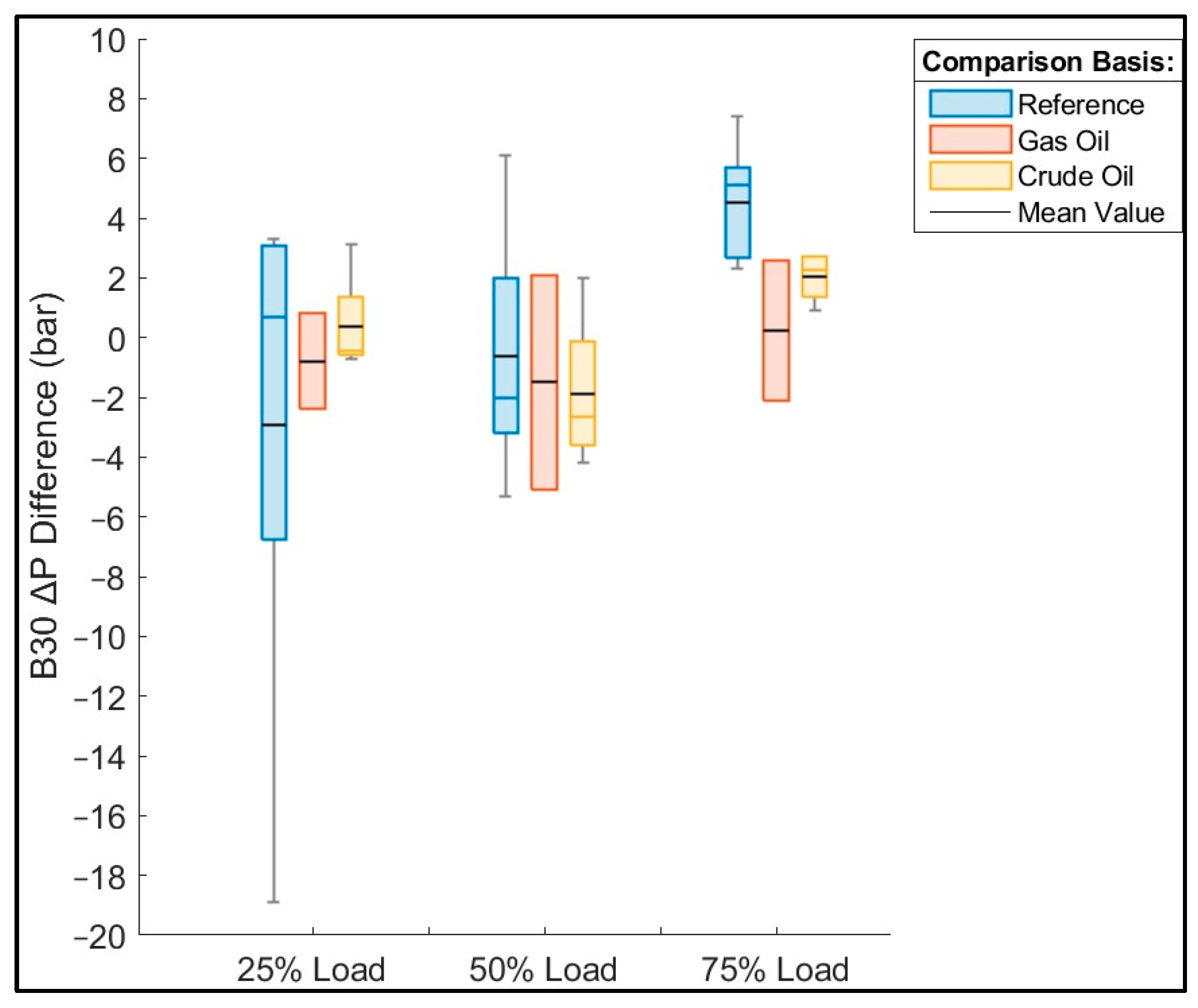

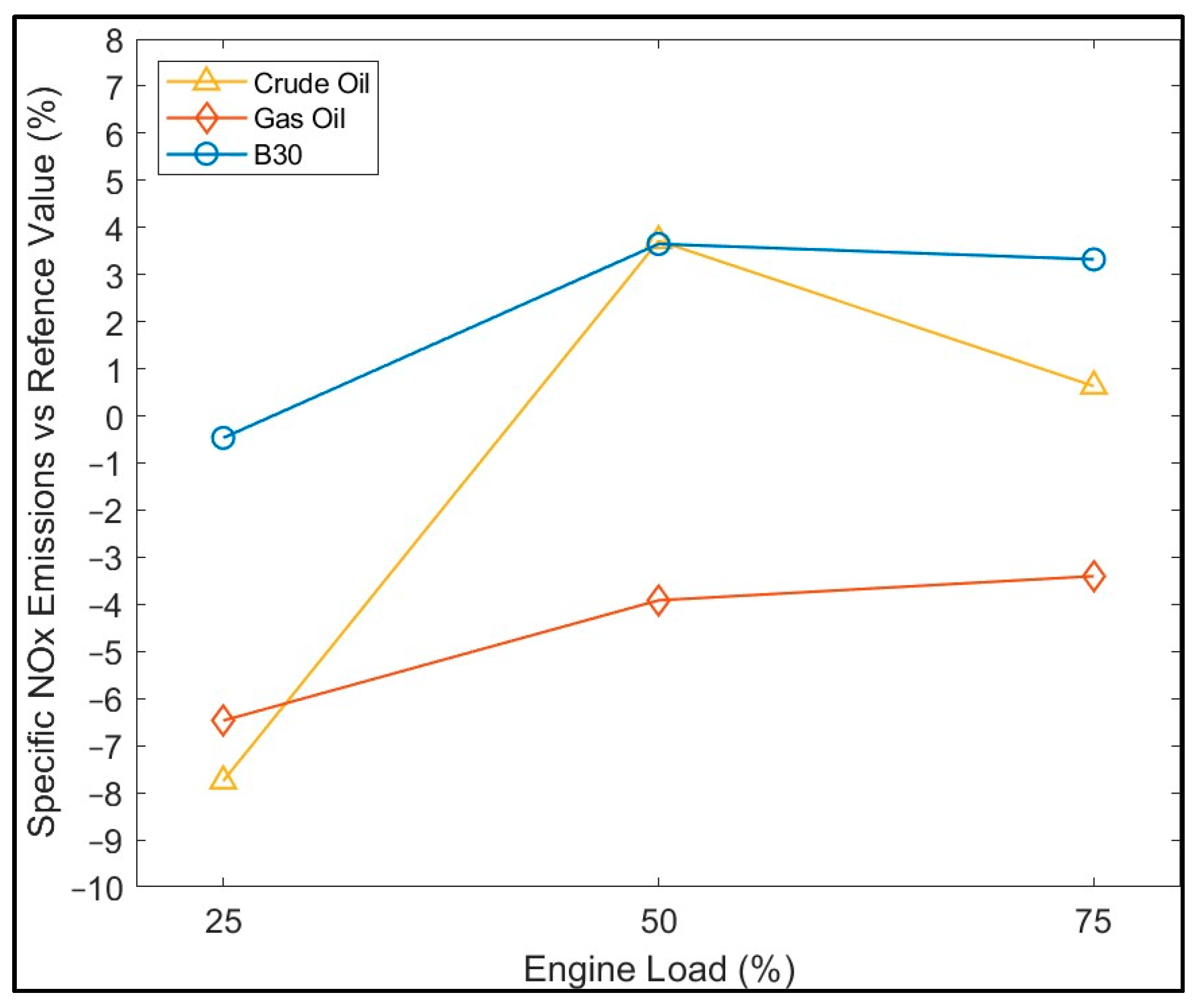
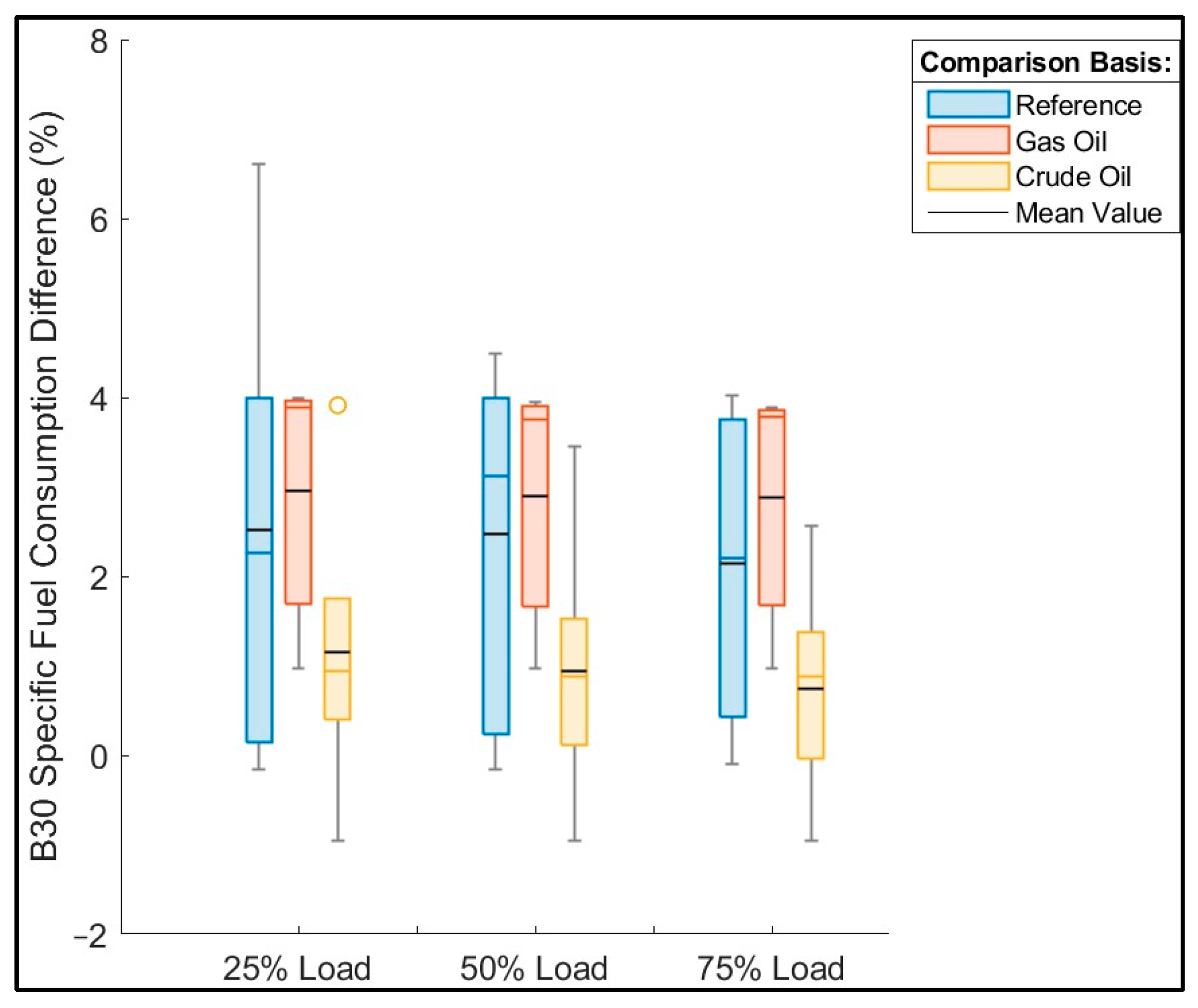

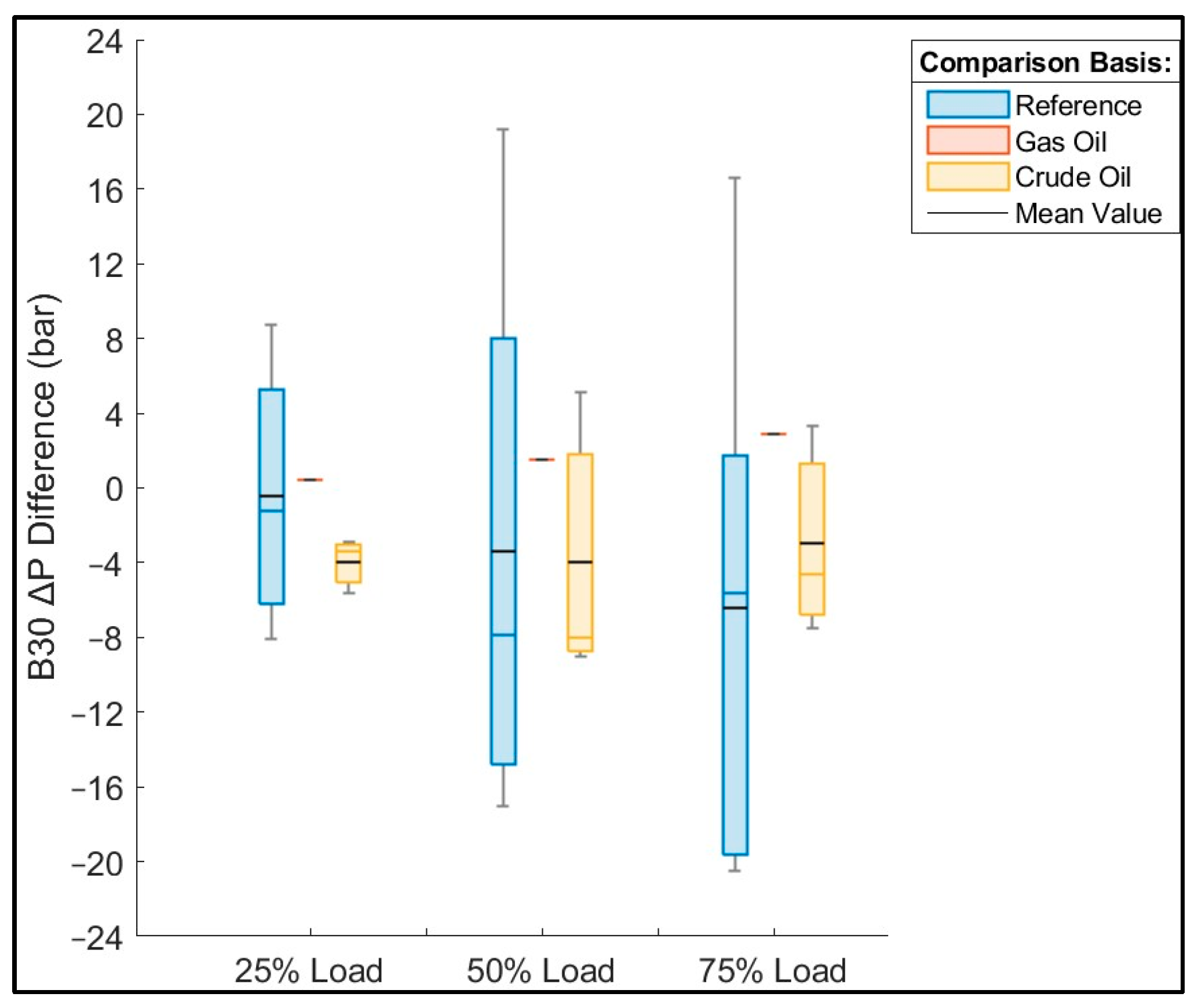
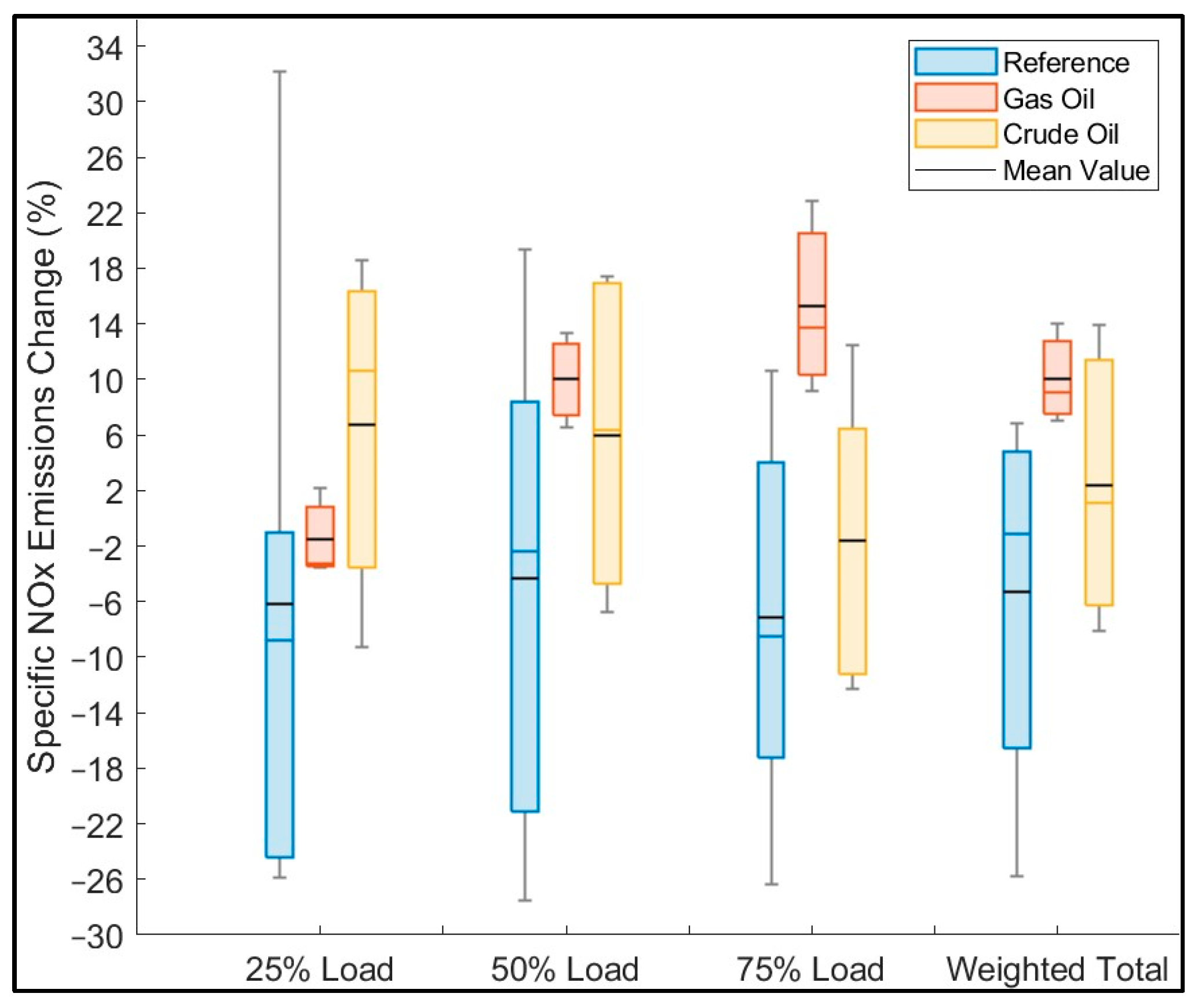

| Instrument | Measured Parameter | Range | Accuracy |
|---|---|---|---|
| Torquemeter | Torque | 0–250 rpm | <0.5% |
| Speed | 0.1 rpm | ||
| Power Meter | Electrical Power | 0.1 kW | |
| Coriolis Mass Flowmeter | Fuel Consumption | 0–10,000 kg/h | 0.30% |
| Volumetric Flowmeter | Fuel Consumption | 0–2500 L/min | 1.50% |
| Cylinder Pressure Sensor | Cylinder Pressure | 0–250 Bar | 0.50% |
| Scavenge Pressure Sensor | Scavenging air Pressure | 0–10 Bar | 0.10% |
| Scavenge Temperature Sensor | Scavenging air Temperature | −10–80 °C | 0.2 °C |
| Exhaust Temperature Sensor | Exhaust Gas Temperature | −10–600 °C | 0.5 °C |
| Instrument | Measured Parameter | Range | Accuracy |
|---|---|---|---|
| Testo 350 Maritime | CO2 | 0–25 %vol | ±0.3 %vol |
| O2 | 0–25 %vol | ±0.3 %vol | |
| NOx | <100–1999 ppm | ±5% | |
| CO | 0–10,000 ppm | ±5% | |
| SO2 | 0–5000 ppm | ±5% | |
| Ambient pressure, absolute | 600–1150 hPa | ±10 hPa | |
| Humidity Meter | Ambient Humidity | 0–100 %RH | ±2% |
| Engine No. | 1 | 2 | 3 | 4 | 5 |
|---|---|---|---|---|---|
| Cylinder No. | 6 | 6 | 6 | 6 | 6 |
| Rated Speed (rpm) | 75 | 77 | 85.5 | 89 | 89 |
| Rated Power (kW) | 15,748 | 10,215 | 16,780 | 9660 | 9660 |
| Bore (mm) | 700 | 600 | 700 | 600 | 600 |
| Stroke (mm) | 3256 | 2790 | 2800 | 2400 | 2400 |
| Electronic Control | Yes | Yes | Yes | Yes | Yes |
| Fuels Tested | B30, HFO, MGO | B30, VLSFO, MGO | B30, VLSFO | B30, VLSFO | B30 |
| Engine No. | 1 | 2 | 3 | 4 | 5 |
|---|---|---|---|---|---|
| Cylinder No. | 6 | 6 | 6 | 6 | 6 |
| Rated Speed (rpm) | 900 | 900 | 900 | 900 | 900 |
| Rated Power (kW) | 970 | 970 | 1710 | 610 | 610 |
| Bore (mm) | 220 | 220 | 210 | 185 | 185 |
| Stroke (mm) | 320 | 320 | 320 | 280 | 280 |
| Fuels Tested | B30, HFO, MGO | B30, HFO, MGO | B30, VLSFO | B30 | B30 |
| Units Tested (#) | 1 | 1, 3 | 2, 3 | 1 | 1 |
| Vessel No. | 1 | 2 | 3 | 4 | 5 | ||||||
|---|---|---|---|---|---|---|---|---|---|---|---|
| Fuel Type | B30 | VLSFO | MGO | B30 | HFO | MGO | B30 | VLSFO | B30 | VLSFO | B30 |
| LCV (kcal/kg) | 9563.3 | 9864.3 | 10,122.3 | 9575.23 | 9548.95 | 10,172.49 | 9608.27 | 9790.24 | 9981.37 | 9904.92 | 9981.37 |
| Density @ 15 °C (kg/m3) | 930.2 | 970 | 880.2 | 930 | 989.7 | 863.1 | 929.5 | 979.6 | 939.6 | 956.1 | 934.9 |
| Viscosity @ 50 °C (cSt) | 38.37 | 154.7 | 3.812 | 38.66 | 357.8 | 3.591 | 37.7 | 37.7 | 6.7 | 194.8 | 44.7 |
| Sulfur (%m/m) | 36 | 0.45 | 0.069 | 0.35 | 3.23 | 0.078 | 0.36 | 0.47 | 0.34 | 0.47 | 0.48 |
| CCAI | 821 | 841 | - | 820 | 851 | - | 818 | 870 | 867 | 824 | 823 |
| Cetane No. | - | - | 41 | - | - | 47 | - | - | - | - | - |
| Carbon (%m/m) | 84.4 | 86.9 | 87.4 | 83.7 | 84.3 | 87.6 | 81.9 | 86.9 | 82.1 | 85.8 | 80.5 |
| Hydrogen (%m/m) | 11.9 | 11.1 | 12.6 | 11.8 | 10.3 | 12.1 | 12.2 | 11.1 | 10.6 | 12.1 | 10.8 |
| Nitrogen (%m/m) | 0.2 | 0.4 | 0.11 | 0.48 | 0.41 | <0.10 | 0.5 | 0.4 | 0.2 | 0.45 | 0.2 |
| Oxygen (%m/m) | 3.22 | <0.2 | <0.2 | 3.67 | 1.76 | 0.22 | 4.69 | 0.2 | 1.6 | <0.2 | 3.1 |
| FAME (%V/V) | 28.31 | <0.1 | <0.1 | 29.7 | <0.10 | 0.2 | 34.15 | <0.10 | 25 | <0.10 | 28.54 |
| B30 | B30 | ||||||||||
| 9981.37 | 9981.37 | ||||||||||
| 934.9 | 934.9 | ||||||||||
| 44.7 | 44.7 | ||||||||||
| 0.48 | 0.48 | ||||||||||
| 823 | 823 | ||||||||||
| - | - | ||||||||||
| 80.5 | 80.5 | ||||||||||
| 10.8 | 10.8 | ||||||||||
| 0.2 | 0.2 | ||||||||||
| 3.1 | 3.1 | ||||||||||
| 28.54 | 28.54 | ||||||||||
| B30 | B30 | ||||||||||
| Engine 1 | Engine 2 | |||||||
| Specific Emissions (%) | 25% Load | 50% Load | 75% Load | Total Weighted | 25% Load | 50% Load | 75% Load | Total Weighted |
| Reference | −0.47 | 3.65 | 3.22 | 9.89 | −6.85 | 12.85 | −5.06 | 4.20 |
| Gas Oil | 6.42 | 7.87 | 6.96 | 7.07 | - | - | - | - |
| Crude Oil | 7.90 | −0.06 | 2.67 | 2.61 | −2.30 | −0.79 | −1.96 | −1.90 |
| Pmax (bar) | ||||||||
| Reference | −4.50 | −3.30 | −3.10 | 5.00 | 1.60 | 2.50 | ||
| Gas Oil | −2.20 | −0.10 | −1.60 | - | - | - | ||
| Crude Oil | −1.30 | −1.40 | 2.20 | −0.50 | −0.30 | −1.10 | ||
| ΔP (bar) | ||||||||
| Reference | −2.70 | −2.00 | 5.10 | 3.30 | −2.50 | 5.10 | ||
| Gas Oil | 0.80 | 2.10 | 2.60 | - | - | - | ||
| Crude Oil | −0.40 | −2.30 | 2.70 | −0.50 | −3.00 | 1.80 | ||
| Engine 3 | Engine 4 | |||||||
| Specific Emissions (%) | 25% Load | 50% Load | 75% Load | Total Weighted | 25% Load | 50% Load | 75% Load | Total Weighted |
| Reference | 29.05 | 4.14 | 8.10 | 16.27 | 24.09 | −0.07 | 10.53 | 17.09 |
| Crude Oil | 7.90 | 10.25 | 13.45 | 11.77 | - | - | - | - |
| Pmax (bar) | ||||||||
| Refrence | 3.10 | −8.80 | −2.50 | −15.20 | −0.80 | −2.40 | ||
| Crude Oil | −4.90 | −3.30 | −1.10 | - | - | - | ||
| ΔP (bar) | ||||||||
| Reference | 0.70 | 6.10 | 7.40 | −18.90 | −5.30 | 2.80 | ||
| Gas Oil | 3.10 | 2.00 | 2.70 | - | - | - | ||
| Engine 5 | ||||||||
| Specific Emissions (%) | 25% Load | 50% Load | 75% Load | Total Weighted | ||||
| Reference | −0.30 | −16.67 | −5.15 | −0.14 | ||||
| Gas Oil | 10.66 | −17.34 | −9.47 | −9.40 | ||||
| Crude Oil | 15.37 | −1.25 | −0.08 | 0.97 | ||||
| Pmax (bar) | ||||||||
| Reference | 6.10 | −5.50 | −2.00 | |||||
| Gas Oil | −8.50 | −14.90 | −8.30 | |||||
| Crude Oil | −3.90 | −8.60 | −0.20 | |||||
| ΔP (bar) | ||||||||
| Reference | 3.00 | 0.60 | 2.30 | |||||
| Gas Oil | −2.40 | −5.10 | −2.10 | |||||
| Crude Oil | −0.70 | −4.20 | 0.90 | |||||
| Auxiliary Generator 1 | Auxiliary Generator 2 | |||||||
| Specific Emissions (%) | 25% Load | 50% Load | 75% Load | Total Weighted | 25% Load | 50% Load | 75% Load | Total Weighted |
| Reference | −13.12 | 1.45 | 10.59 | 3.86 | −1.06 | −6.3 | −8.54 | −6.34 |
| Gas Oil | 2.15 | 6.55 | 9.18 | 7.03 | - | - | - | - |
| Crude Oil | 10.62 | 17.4 | 12.44 | 13.97 | −9.23 | −3.99 | −10.8 | −8.11 |
| Pmax | ||||||||
| Reference | −2.5 | −8.1 | −19.5 | −2.6 | −11.3 | −16.6 | ||
| Gas Oil | 0.9 | 2.9 | 4 | - | - | - | ||
| Crude Oil | −5.4 | 3.8 | 3.8 | −2.1 | −7.5 | −5.2 | ||
| ΔP | ||||||||
| Reference | 1.9 | −3.2 | −5.6 | −4.4 | −12.6 | −19.4 | ||
| Gas Oil | 0.4 | 1.5 | 2.9 | |||||
| Crude Oil | −5.6 | 5.1 | 3.3 | −3.4 | −8 | −4.6 | ||
| Auxiliary Generator 3 | Auxiliary Generator 4 | |||||||
| Specific Emissions (%) | 25% Load | 50% Load | 75% Load | Total Weighted | 25% Load | 50% Load | 75% Load | Total Weighted |
| Reference | 32.13 | 8.37 | −1.49 | 6.82 | −4.52 | - | 5.87 | 5.11 |
| Crude Oil | 18.6 | −6.76 | −12.33 | −5.69 | - | - | - | - |
| Pmax (bar) | ||||||||
| Reference | 1.7 | −1.1 | −1.7 | 8.7 | - | 14.3 | ||
| Crude Oil | −1 | −5.5 | −3.3 | - | - | - | ||
| ΔP (bar) | ||||||||
| Reference | −8.1 | −17 | −20.5 | 8.7 | - | 16.3 | ||
| Crude Oil | −2.9 | −9 | −7.5 | - | - | - | ||
| Auxiliary Generator 5 | ||||||||
| Specific Emissions (%) | 25% Load | 50% Load | 75% Load | Total Weighted | ||||
| Reference | - | 19.35 | −10.41 | −1.9 | ||||
| Pmax (bar) | ||||||||
| Reference | - | 18.7 | 8.6 | |||||
| ΔP (bar) | ||||||||
| Reference | - | 19.2 | −3.3 | |||||
| Auxiliary Generator 6 | Auxiliary Generator 7 | |||||||
| Specific Emissions (%) | 25% Load | 50% Load | 75% Load | Total Weighted | 25% Load | 50% Load | 75% Load | Total Weighted |
| Reference | −24.45 | −21.11 | −19.5 | −19.98 | −25.83 | −27.57 | −26.4 | −25.75 |
| Gas Oil | −3.52 | 10.08 | 13.7 | 9.08 | −3.29 | 13.36 | 22.84 | 12.97 |
| Crude Oil | −1.64 | 6.34 | −1.58 | 1.12 | 15.56 | 16.75 | 4.43 | 10.58 |
Disclaimer/Publisher’s Note: The statements, opinions and data contained in all publications are solely those of the individual author(s) and contributor(s) and not of MDPI and/or the editor(s). MDPI and/or the editor(s) disclaim responsibility for any injury to people or property resulting from any ideas, methods, instructions or products referred to in the content. |
© 2023 by the authors. Licensee MDPI, Basel, Switzerland. This article is an open access article distributed under the terms and conditions of the Creative Commons Attribution (CC BY) license (https://creativecommons.org/licenses/by/4.0/).
Share and Cite
Chountalas, T.D.; Founti, M.; Hountalas, D.T. Review of Biofuel Effect on Emissions of Various Types of Marine Propulsion and Auxiliary Engines. Energies 2023, 16, 4647. https://doi.org/10.3390/en16124647
Chountalas TD, Founti M, Hountalas DT. Review of Biofuel Effect on Emissions of Various Types of Marine Propulsion and Auxiliary Engines. Energies. 2023; 16(12):4647. https://doi.org/10.3390/en16124647
Chicago/Turabian StyleChountalas, Theofanis D., Maria Founti, and Dimitrios T. Hountalas. 2023. "Review of Biofuel Effect on Emissions of Various Types of Marine Propulsion and Auxiliary Engines" Energies 16, no. 12: 4647. https://doi.org/10.3390/en16124647
APA StyleChountalas, T. D., Founti, M., & Hountalas, D. T. (2023). Review of Biofuel Effect on Emissions of Various Types of Marine Propulsion and Auxiliary Engines. Energies, 16(12), 4647. https://doi.org/10.3390/en16124647








